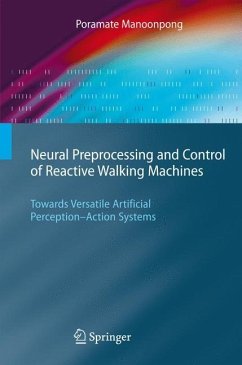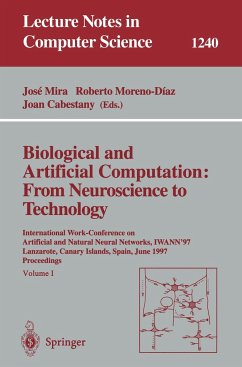
Neural Preprocessing and Control of Reactive Walking Machines
Towards Versatile Artificial Perception-Action Systems
Versandkostenfrei!
Versandfertig in 6-10 Tagen
38,99 €
inkl. MwSt.
Weitere Ausgaben:

PAYBACK Punkte
19 °P sammeln!
This book presents biologically inspired walking machines interacting with their physical environment, and shows how the morphology and behavior control of machines can benefit from biological studies. The purpose is to develop a modular structure of neural control generating reactive behaviors of the physical walking machines, to analyze the neural mechanisms underlying them, and to demonstrate the sensor fusion technique leading to smooth switching between appropriate behaviors, like obstacle avoidance and sound tropism.
Biologically inspired walking machines are fascinating objects to study, from thepointofviewoftheirmechatronicaldesignaswellastherealisationofc- trol concepts. Research on this subject takes its place in a rapidly growing, highly interdisciplinary ?eld, uniting contributions from areas as diverse as biology, biomechanics, material science, neuroscience, engineering, and c- puter science. Nature has found fascinating solutions for the problem of legged loco- tion, and the mechanisms generating the complex motion patterns performed by animals are still not very well understood. Natural movements provide the impressionofeleganceandsmoothness,whereastheimitationoftheirarti?cial analogues still looks rather clumsy. The diverse research on arti?cial legged locomotion mainly concentrated on the mechanical design and on pure movement control of these machines; i.e., in general these machines were unable to perceive their environment and reactappropriately.Contributionsdevelopingembodiedcontroltechniquesfor sensor-driven behaviors are rare, and if considered, they deal only with one type of behavior; naturally, this is most often an obstacle avoidance behavior. There are only a few approaches devoted to the multimodal generation of several reactive behaviors. This book presents a pioneering approach to tackle this challenging pr- lem. Inspired by the obstacle avoidance and escape behaviors of cockroaches and scorpions, which here are understood as negative tropisms, and by the prey-capturing behavior of spiders, taken as a positive tropism, corresponding sensors and neural control modules are introduced in such a way that wa- ing machines can sense and react to environmental stimuli in an animal-like fashion.














